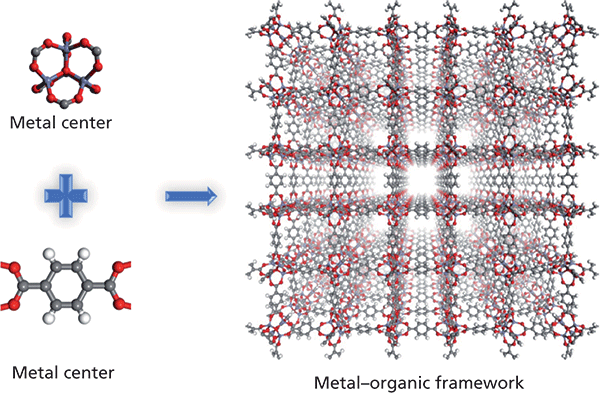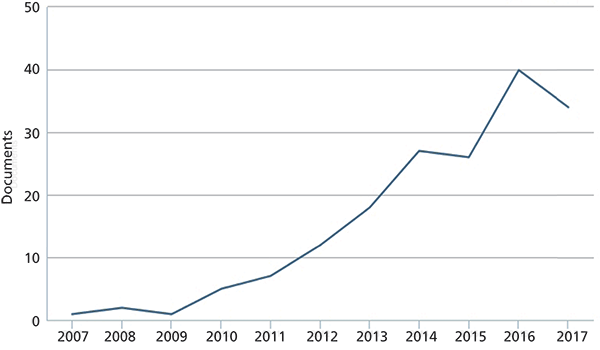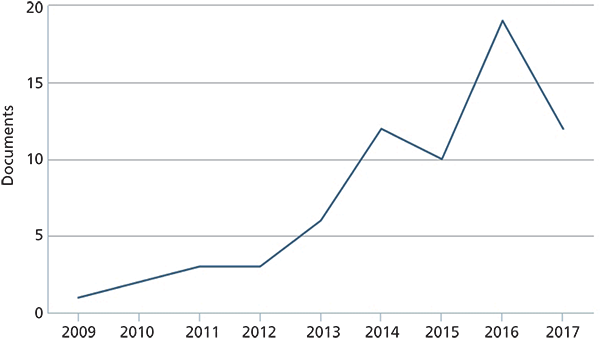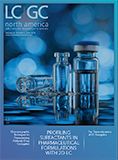The Promise of Metal–Organic Frameworks for Use in Liquid Chromatography
LCGC North America
What can metal–organic frameworks offer for liquid chromatography?
Metal–organic frameworks (MOFs) are self-assembled combinations of metals and inorganic ligands that result in a relatively young class of highly ordered, porous materials. Because of the number of structural and chemical possibilities, high surface area, controlled pore volume, and thermal properties, MOFs are being applied in a number of fields, including chromatography. Although there has been limited application of MOFs for liquid chromatography (LC), early studies have revealed great promise. In this installment of “Column Watch,” recent investigations toward the application of MOFs specifically for LC are presented and discussed.
Metal–organic frameworks (MOFs) are a relatively young class of highly ordered porous materials possessing chemical and physical properties that are potentially applicable to a variety of applications, including high performance liquid chromatography (HPLC). MOFs are composed of organic ligands and inorganic metals or metal-oxo units (often referred to as secondary building units [SBUs]) in long-range order, resulting in permanent, porous, open crystalline frameworks (1). MOFs may be assembled from a variety of metals and a large number of organic linkers, making the possibilities virtually endless. The metal, or metal-containing component, plays an important role in directing the MOF structure, which largely depends on the coordination number and geometry of the metal. The organic linkers could provide influence over the shape of the MOF. The ligands contain coordination functional groups that work to lock the metal ions into their positions. Through careful control of synthetic conditions, it is possible to control and predict the structure of the resulting framework as well as its properties for specific application (1). Figure 1 shows a representation of MOF-5, one of the most studied structures. MOF particles may be used directly, adapted via post-synthetic modification, or combined with other materials as composites or as newly designed architectures. MOFs have shown utility in both achiral and chiral applications.

Figure 1: Schematic drawing of a metal–organic framework (MOF) structure (MOF-5 is shown in the figure, where the metal center is Zn4O center, and the organic linker is terephthalate [1,4-benzodicarboxylate]). (Figure courtesy of Xueyi Zhang, of the Pennsylvania State University.)
One focus of modern development in HPLC has been to improve performance by targeting advances in particle design. The first major improvement came with smaller, sub-2-µm particles and the instrumentation to limit extracolumn dispersion and handle the higher back pressures afforded by the smaller particles. Modern superficially porous particles (SPPs) for use with small molecule separations were introduced in 2006. The advantage of SPPs was that the technology provided nearly similar efficiencies to the sub-2-µm particles, but at a lower cost of back pressure because of the larger overall particle size. The lower back pressure then allowed for use of the technology across a wider array of HPLC systems (2). Another recent focus has been directed toward the control and uniformity of particle pores to improve efficiency. Barber and colleagues recently described a patented preparation of highly ordered pores through a process called pseudomorphic transformation and compared this approach to standard preparations of superficially porous materials (3). The researchers demonstrated high efficiencies when these particles were packed in HPLC columns, concluding that the high efficiencies are a result of the uniform diffusion pathways resulting from the ordered pore structure (4).
Along with this current trend toward more uniform surfaces and pore structures for HPLC applications, it is possible that MOFs, with their controllable and predictable pore size and geometries, could be used as highly efficient materials for chromatographic purposes. The application of MOFs for chromatographic separation has grown in recent years. Figure 2 shows the results of a rudimentary literature search using the terms "MOFs" and "chromatography." It is clear from the figure that interest is rising rapidly. Figure 3 shows a similar trend where the search is limited to research directed toward HPLC.

Figure 2: Recent trend in articles published featuring MOFs in chromatography. (Adapted with permission from Elsevier B.V./Scopus, copyright 2018.)
Investigations of MOFs for use in liquid chromatography (LC) have been limited; however, these investigations have shown promise for the technology. Alaerts and coworkers were the first to report the use of MOF materials for LC applications (5). MOFs denoted MIL-47 and MIL-53 were investigated for the separation of aromatic isomers, among others, under normal-phase conditions using hexane as the mobile phase. Based on adsorption studies, both entropic and enthalpic effects were suggested as responsible for the selectivity observed. Relative to modern chromatography, peak efficiency was quite poor; however, the studies did show MOFs as potentially useful for LC purposes.

Figure 3: Recent trend in articles published featuring MOFs specifically in liquid chromatography. (Adapted with permission from Elsevier B.V./Scopus, copyright 2018.)
MIL-47 and MIL-53 were also explored using binary mobile phases consisting of dichloromethane and hexane by Yan and coworkers (6). Baseline separations with improved efficiencies were reported (up to 10,200 plates/m), demonstrating improvements compared to previous studies, but still falling well short of modern chromatographic efficiencies using silica-based materials. The Yan group further explored the use of MIL-100(Fe) for both normal-phase and reversed-phase HPLC. Although the results showed poor efficiencies because of the irregular particle shapes generated, selectivity was shown to be changed with temperature, which could prove useful for temperature-dependent separations. In addition, the studies suggested the presence of separation mechanisms based on π-π, hydrogen bonding, and coordination interactions (7).
The fabrication of MOF particles generally involves some sort of pulverization that results in irregularly shaped fragments and relatively large particle size distributions. In an attempt to overcome these issues, Yan and colleagues fabricated MOF-based superficially porous materials (8). In this effort, zeolitic imidazolate framework 8 (ZIF-8) was grown on 3-µm silica spheres. The resultant material was packed in 5 cm × 4.6 mm columns and investigated for efficiency using bisphenol A. Efficiencies up to 23,000 plates/m were reported, demonstrating a further improvement over previous studies. Although these efficiencies are again far away from modern performance standards, the study shows the potential fusion of modern day particle design and MOF technologies.
As demonstrated in the previous example, MOFs can be applied to chromatographic separations on their own or in combination with additional particle technologies. Zhang and colleagues demonstrated that composite materials combining UIO-66 MOFs and silica can also be accomplished (9). The composite material was shown to provide selectivity for a variety of organic probes, including isomers, in a reproducible fashion. Efficiencies, however, remained low.
MOFs can be further modified following their synthesis. Yang and colleagues reported the post-synthetic modification of MIL-101(Cr), in which the researchers compared selectivity and efficiency of the resultant material to the unmodified MOF and a 5-µm silica-based amino column for the separation of tocopherols (10). A simple and efficient post modification of the MOF with pyridine showed improved selectivity and efficiency for the separation. The authors also noted that the pyridine-based MOF demonstrated improved selectivity and efficiency (up to 75,000 plates/m) as compared to the commercial amino phase.
The small pore size of many MOFs may inhibit interaction of larger molecules, limiting their application. Larger pore sizes may be designed; however, the large space often results in interpenetration or the simultaneous growth of multiple frameworks in the same space. Interpenetration may be controlled by changing the reactant concentrations, modifying reaction conditions, or by selecting a suitable topology for the MOF (1).
MOFs have also garnered considerable attention for their potential use in asymmetric catalysis and chiral separations in various forms of chromatography. Chiral MOFs may be prepared directly using chiral ligands or by a variety of post synthetic modification strategies (11). Homochiral MOFs, because of the ability to design access channels and purposefully alter their pore size and shape, may prove highly useful as chiral chromatographic stationary phases. In a very recent example, Xie and colleagues reported on the synthesis and chromatographic evaluation of (Cu[S-mal][bpe])n, where S-mal denotes (S)-malic acid and bpe is trans-1,2-bis(4-pyridyl)ethylene (12). The chiral MOF was shown to separate racemates of 16 different compounds across a variety of compound classes. Numerous additional applications of homochiral MOFs have been shown to be selective for several classes of racemates. As with achiral applications, highly efficient separations will require significantly more research.
Conclusions
Metal–organic frameworks are a relatively new class of porous materials that exhibit chemical and physical properties that show promise for use as chromatographic media. A significant amount of research has been conducted during the past decade applying and investigating MOFs for selective sample preparation, gas chromatography, and liquid chromatography. Although promise remains high for applications of MOFs in HPLC, the materials have not yet reached the performance of modern particle technologies. MOF particle preparation often results in irregularly shaped crystals of comparatively large particle size distributions. Columns packed with such material are thus prone to inefficient performance. In addition, increasing the size of channels within the MOF structure may be required to allow larger molecules to interact. Attempts at creating larger pores can result in interpenetration where multiple frameworks grow and interfere with each other. More efforts in MOF design and particle architecture, such as the construction of core–shell materials, may prove to overcome these deficiencies and allow the favorable properties of MOFs to shine through.
Acknowledgments
The author would like to thank Xueyi Zhang, Assistant Professor in the Department of Chemical Engineering at The Pennsylvania State University for contributing figures, reviewing the article, and fruitful conversations.
References
(1) K. Yusuf, A. Aqel, and Z. Alothman, J. Chromatogr. A 1348, 1–16 (2014).
(2) D.S. Bell and R.E. Majors, LCGC North Am. 33(6), 386–395 (2015).
(3) W. Barber et al., "Next Generation Superficially Porous Particle Technology: Highly Ordered Pore Structures Formed By Pseudomorphic Transformation," presented at the 43rd International Symposium of High Performance Liquid Phase Separations and Related Techniques (HPLC 2015), Geneva, Switzerland, 2015.
(4) D.S. Bell, X. Wang, and R.E. Majors, LCGC North Am. 33(9), 682–693 (2015).
(5) L. Alaerts et al., Angew. Chem., Int. Ed. 46, 4293–4297 (2007).
(6) S.S. Liu, C.X. Yang, S.W. Wang, and X.P. Yan, Analyst 137, 816–818 (2012).
(7) Y.Y. Fu, C.X. Yang, and X.P. Yan, J. Chromatogr. A 1274, 137–144 (2013).
(8) Y.Y. Fu, C.X. Yang, and X.P. Yan, Chem. - Eur. J. 19, 13484–13491 (2013).
(9) Z. Yan et al., J. Chromatogr. A 1366, 45–53 (2014).
(10) F. Yang, C.X. Yang, and X.P. Yan, Talanta 137, 136–142 (2015).
(11) S. Bhattacharjee, M.I. Khan, X. Li, Q.L. Zhu, and X.T. Wu, Catalysts 8(3), 120 (2018).
(12) S. Xie et al., Microchem. J. 139, 487–491 (2018).
ABOUT THE AUTHORS
David S. Bell

David S. Bell is a director of Research and Development at Restek. He also serves on the Editorial Advisory Board for LCGC and is the Editor for "Column Watch." Over the past 20 years, he has worked directly in the chromatography industry, focusing his efforts on the design, development, and application of chromatographic stationary phases to advance gas chromatography, liquid chromatography, and related hyphenated techniques. His undergraduate studies in chemistry were completed at the State University of New York at Plattsburgh (SUNY Plattsburgh). He received his PhD in analytical chemistry from The Pennsylvania State University and spent the first decade of his career in the pharmaceutical industry performing analytical method development and validation using various forms of chromatography and electrophoresis. His main objectives have been to create and promote novel LC technologies and to conduct research on molecular interactions that contribute to retention and selectivity in an array of chromatographic processes. His research results have been presented in symposia worldwide, and have resulted in numerous peer-reviewed journal and trade magazine articles. Direct correspondence to: LCGCedit@ubm.com
